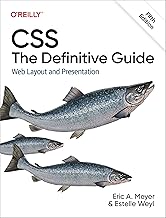Crafting a Comprehensive White Paper Expanding on "CSS: The Definitive Guide"
Introduction
Eric Meyer's "CSS: The Definitive Guide" is a cornerstone resource for web developers, offering a deep dive into Cascading Style Sheets. This white paper aims to expand upon its foundational concepts, delving into advanced techniques, modern CSS methodologies, and best practices. By incorporating insights from industry experts and recent developments, we aim to provide a comprehensive resource for both novice and experienced web designers.
Core Concepts and Advanced Techniques
- CSS Selectors: Beyond the Basics
- Complex Selectors: Mastering the art of combining selectors for precise targeting.
- Attribute Selectors: Leveraging attributes to style elements dynamically.
- Pseudo-classes and Pseudo-elements: Creating dynamic styles based on an element's state or position.
- CSS Layout: Grid and Flexbox Mastery
- Grid Layout: Building complex layouts with rows and columns.
- Flexbox: Creating flexible and responsive layouts.
- CSS Grid and Flexbox Together: Combining strengths for versatile designs.
- CSS Animations and Transitions:
- Keyframes and Timing Functions: Creating smooth and engaging animations.
- Transitions: Adding subtle effects to style changes.
- Performance Optimization: Ensuring smooth animations without sacrificing performance.
- CSS Preprocessors and Postprocessors:
- Sass and Less: Extending CSS syntax with variables, mixins, and functions.
- PostCSS: Automating tasks and adding advanced features.
- Benefits and Best Practices: Leveraging preprocessors for efficient development.
Modern CSS Methodologies
- CSS-in-JS:
- Benefits and Drawbacks: Integrating styles directly into JavaScript components.
- Popular Libraries: Styled-Components, Emotion, and others.
- Best Practices: Writing maintainable and performant CSS-in-JS code.
- Functional CSS:
- Atomic Design: Breaking down UI components into smaller, reusable parts.
- Utility-First CSS: Building layouts with low-level utility classes.
- Benefits and Challenges: Creating scalable and consistent styles.
- Responsive Design and Mobile-First Approach:
- Media Queries: Adapting layouts to different screen sizes.
- Fluid Grids and Flexible Images: Creating responsive layouts.
- Mobile-First Development: Prioritizing mobile devices in the design process.
Best Practices and Performance Optimization
- CSS Performance Optimization:
- Minification and Compression: Reducing file size.
- Efficient Selectors: Writing performant CSS rules.
- Leveraging the Browser Cache: Optimizing asset delivery.
- CSS Accessibility:
- Semantic HTML: Using meaningful HTML elements.
- Accessible Color Contrast: Ensuring readability for all users.
- Keyboard Navigation: Making websites accessible to keyboard-only users.
- CSS Maintainability and Scalability:
- Modular CSS: Organizing styles into reusable components.
- CSS Naming Conventions: Creating a consistent naming system.
- Version Control: Tracking changes and collaborating effectively.
Reference List
- Books:
- Meyer, E. (2014). CSS: The Definitive Guide. O'Reilly Media.
- Powell, A. (2018). Smashing Book: Responsive Web Design. Smashing Magazine.
- Leaver, T. (2018). CSS Master. SitePoint.
- Online Resources:
- MDN Web Docs: https://css-tricks.com/
- Smashing Magazine: https://alistapart.com/
- Frameworks and Libraries:
- Bootstrap: https://tailwindcss.com/
- Materialize:
By expanding upon the foundation laid by "CSS: The Definitive Guide" and incorporating modern techniques, this white paper aims to empower web developers to create stunning, performant, and accessible websites.
Note: This is a high-level outline. To create a truly comprehensive white paper, consider diving deeper into each section, providing practical examples, code snippets, and visual demonstrations. Additionally, staying up-to-date with the latest CSS specifications and industry trends is crucial for a truly definitive guide. Contact ias-research.com for details.



